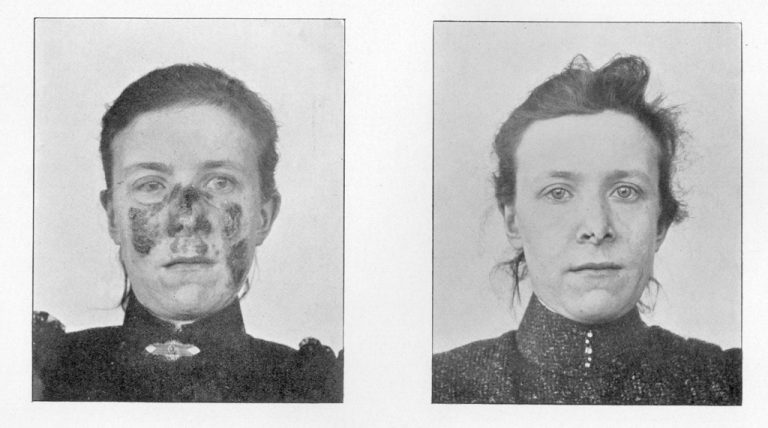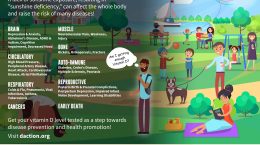Published on May 27, 2022
Knowing the history of how sunlight exposure has been utilized to cure disease and improve health is important for understanding why it is still so essential today
Key Points
- The “Diseases of Darkness” that are associated with vitamin D deficiency, such as rickets, and other negative health effects resulting from a lack of sun exposure still exist today, and yet are absolutely avoidable and unnecessary
- Sunlight and artificial UV were the most effective treatments of these diseases of darkness until the 1950s with the invention of antibiotics
- Below is a timeline list of sunshine discoveries made and the uses of sunlight for health and wellbeing throughout history
 Major changes in the way we live, especially over the past century, have affected the amount of sunshine we are exposed to on a daily basis, which for most people, is minimal. These days, most work is done indoors, digital devices have become a popular form of indoor entertainment, and air conditioning makes being indoors on a hot and sunny day easily attractive. Negative messages about the sun and skin cancer, even tanning, have scared people into staying indoors or covering up at all times when going outdoors, to the point where the body is unable to reap the benefits of sunshine and UV exposure. The “Diseases of Darkness” that are associated with vitamin D deficiency, such as rickets, and other negative health effects resulting from a lack of sun exposure still exist today, and yet are absolutely avoidable and unnecessary. In fact, in 2012 the UK cited 833 hospital admissions for rickets, more than four times the amount 10 years earlier.
Major changes in the way we live, especially over the past century, have affected the amount of sunshine we are exposed to on a daily basis, which for most people, is minimal. These days, most work is done indoors, digital devices have become a popular form of indoor entertainment, and air conditioning makes being indoors on a hot and sunny day easily attractive. Negative messages about the sun and skin cancer, even tanning, have scared people into staying indoors or covering up at all times when going outdoors, to the point where the body is unable to reap the benefits of sunshine and UV exposure. The “Diseases of Darkness” that are associated with vitamin D deficiency, such as rickets, and other negative health effects resulting from a lack of sun exposure still exist today, and yet are absolutely avoidable and unnecessary. In fact, in 2012 the UK cited 833 hospital admissions for rickets, more than four times the amount 10 years earlier.
History has demonstrated to us that, in many different health circumstances, natural as well as artificial sunlight can act as a major interventional tool to prevent and heal devastating diseases, when used with diligence. Before the ‘era of antibiotics’ phototherapy was a state-of-the-art treatment in contemporary medicine, and where natural sunlight was unavailable, artificial sunlight was successfully used to fill the gap. Now days, the message so often heard is to stay out of the sun, or to cover up when exposed to sunshine. What could the resulting health effects be from this type of sun avoidance? Why are so many ignoring the lessons learned throughout history about the benefits of sunshine exposure?
Lessons from History: Sunshine is Essential for Our Health
Knowing the history of how sunlight exposure has been utilized to cure disease and improve health is important for understanding why it is still so essential today. For this reason, Dr. Michael Holick began his recent paper “The CO-VID D-Lemma: A Call for Action” with a time-line list of individuals throughout history who discovered specific ways that sunshine exposure improved health and who “appreciated the life-giving properties of sun exposure.”
Another historical perspective on the use of sunlight for health is given in this recorded seminar presentation by Alexander Wunsch, MD, Wismar University of Applied Sciences, Germany. Dr. Wunsch explains how both the public and medical community’s perspective on sunlight has changed over time, while also covering additional information about the healing properties of sunlight.
Below is a timeline list of sunshine discoveries made and the uses of sunlight for health and wellbeing throughout history.
Ancient Greece or Egypt (4000-5000 years ago)
- The beginning of heliotherapy, or the use of sunshine for its healing properties
- The sun was mentioned in ‘medication recipes’ and for certain medical preparations, disinfection, and photochemical reactions. Sunlight was used to control germs on skin and in the environment.
Herodot (525 BC)

- Looked at skull bones of those who died in the Battle of Pelusium and discovered that Egyptian skull bones were much thicker than those of Persians. He concluded it was the Egyptians’ use of sunlight – shaved heads, a lot of skin to the sun vs the large hats Persians wore. This was the first report of the connection between sunlight and the human system (bone health).
Hippocrates (460-370 BC)
- Centuries ago, Hippocrates (now considered the “Father of Medicine”) observed that the “sunnier side of the hill” was the healthier place to live. Because of this observation, he routinely prescribed sunbaths as part of his therapy for a wide variety of health ailments, using sunlight and its warmth for both medical and psychological purposes.
Ancient Indications for Heliotherapy – shifting of body liquids (movement of blood and lymph into the skin), cauterization (burning of tumors using sunlight and crystals), metabolic disorders, obesity, strengthening the bones and preventing rickets.
Fast-Forward 2500 Years Later, Into the Age of the Industrial Revolution
Diseases of Darkness, namely rickets and tuberculosis, skyrocketed during the industrial revolution – smog and dirt in the air, tall buildings reduced sunlight in cities, and it was soon discovered that going back into sunlight and nature cured rickets in children. Following this came more discoveries as to the therapeutic and healing properties of sunlight and the involvement of vitamin D. The following individuals were key:
Sniadecki (1822) and Palm (1890)
- Made the connection between sunshine deprivation and rickets
Florence Nightingale (1820-1910)
- known as “The Lady with the Lamp” and considered the founder of modern nursing
- observed that her patients in hospital rooms facing east recovered the fastest
- identified sunlight as the key to promoting health in hospitals
- stated “It is the unqualified result of all my experience with the sick, that second only to their need of fresh air is their need of light…And that it is not only light but direct sun-light they want.”
Niels Ryberg Finsen (1860-1904)

- was the first to do scientific experiments to determine the therapeutic properties of light
- used carbon arc lamps and other artificial UV – the start of phototherapy
- won the Nobel Prize for medicine and physiology for developing phototherapy methods for the treatment of lupus vulgaris (skin manifestation of tuberculosis)
August Rollier (1874-1954)

- used sunlight (heliotherapy) in the Swiss mountains to treat and prevent diseases such as tuberculosis and lupus
- never saw a case of skin cancer caused by heliotherapy, in fact, he treated skin cancer with heliotherapy
Kurt Huldschinsky (1883-1940)
- discovered that there was a substance circulating through the body from sun that treated rickets
- used UV lamps on part of the body to increase the amount of this substance in the whole body, leading to the cure of rickets
Adolf Windaus (1876-1959)
- “unlocked the secret of vitamin D synthesis”
- created the first concentrated form of vitamin D
- was awarded the Nobel Prize in 1928
Frank Apperly (1940s)
- More Sunlight = Less Cancer
Sunlight and artificial UV were the most effective treatments of these diseases of darkness until the 1950s with the invention of antibiotics…
Lessons from History to be Remembered and Applied to the Present
A 2020 review of studies on the health effects of sunshine by Alfredsson et al. indicated that 340,000 deaths per year in the United States and 480,000 deaths per year in Europe, as well as a rise in many diseases, could be attributed to insufficient sun exposure or “sunshine deficiency.” It is also known that implementing regular, safe, non-burning sun exposure can help individuals of all skin types maximize the health benefits from the sun while minimizing the risks associated with sun exposure, including that of melanoma. With these in mind, and the lessons that have been learned throughout history about how essential sunshine is for health, implementing sensible sunshine exposure into our modern day lifestyle should be a “no-brainer”!
As suggested by those listed above throughout history, and by recent authors Hoel and De Gruijl, moderate UV exposure from the sun, without burning, is a health benefit and should be recommended as such.
Go outside and get some sunshine!
Make Sure You are Getting Enough Vitamin D TODAY!
 Having and maintaining healthy vitamin D levels and other nutrient levels can help improve your health now and for your future. Choose which additional nutrients to measure, such as your omega-3s and essential minerals including magnesium and zinc, by creating your custom home test kit today. Take steps to improve the status of each of these measurements to benefit your overall health. With measurement you can then determine how much is needed and steps to achieve your goals. You can also track your own intakes, symptoms and results to see what works best for YOU.
Having and maintaining healthy vitamin D levels and other nutrient levels can help improve your health now and for your future. Choose which additional nutrients to measure, such as your omega-3s and essential minerals including magnesium and zinc, by creating your custom home test kit today. Take steps to improve the status of each of these measurements to benefit your overall health. With measurement you can then determine how much is needed and steps to achieve your goals. You can also track your own intakes, symptoms and results to see what works best for YOU.
Enroll in D*action and Test Your Levels Today!





